Justin Koscher, President of the Polyisocyanurate Insulation Manufacturer’s Association, issued the following message for roofing professionals regarding Virtual Roofing Day in D.C. 2021, which was held March 23-24:
As the country continues to cautiously move toward a familiar sense of normalcy, individually and collectively we are looking to rebuild after a year of loss for a brighter, more prosperous future. This March brings a sense of normalcy to the roofing industry as we once again gather as a collective of contractors, manufacturers, design professionals and associations to come together on Capitol Hill as part of the annual Roofing Day in D.C. 2021. While this year’s event will be virtual, the collaborative spirit of coming together for conversations about our role in rebuilding American prosperity is high.
The roofing industry is uniquely placed to make important contributions toward some of the most pressing policy goals of our time, including the creation of reliable employment opportunities, support for critical infrastructure upgrades, and promotion of energy efficient and resilient buildings. There is broad support for these initiatives from both the legislative and executive branches of the federal government. There is a shared vision that the daunting challenge of rebuilding our crumbling infrastructure and making our built environment more resilient in the face of adverse climate impacts present an opportunity to provide workforce training and meaningful employment to many workers impacted by recent job losses.
Quality Roofing Jobs
Even before the pandemic, workforce shortages topped the list of constraints on the growth of roofing and construction companies. Today, many Americans have been displaced from the workforce as a result of the pandemic and fundamental shifts in our economy. Many workers eager for employment face a skills gap in order to pursue careers in new industries. Expanded investment in career and technical education can open opportunities for displaced workers in the roofing and other construction trades.
Professional careers in roofing, construction or manufacturing offer an attractive option for out of work Americans as well as younger generations just entering the workforce. For many years, our national educational policy has focused on sending people to college as the primary path to employment success. This one-size-fits-all approach to post-secondary education overlooks the value of investing in vocational training and careers in skilled trades. Increased federal investments in career and technical education will train the workforce required to meet the challenges of today and tomorrow, and will provide critical support to the many small businesses in the construction and manufacturers sectors that are the entrepreneurial engine that drives the U.S. economy.
Infrastructure Initiatives
This infusion of workers into trades like roofing is especially important at a time when critical upgrades to our national infrastructure are desperately needed. Children in many parts of the country are finally heading back to school, but part of what has delayed their return is the substandard ventilation in their school buildings. The average public school building in the U.S. is more than 40 years old and the current backlog of maintenance and capital projects represents a $380 billion funding gap.
Schools are only a small part of the nation’s infrastructure needs. The American Society of Civil Engineers released a report this month estimating that the country faces a $2.59 trillion shortfall in spending and labeled the current state of our infrastructure as being in “mediocre condition.” The Biden Administration has signaled interest in ambitious plans to address these deficits and the success of these plans depends on the strength of the construction related industries who will be called on to complete these projects.
Building Resilience
Coupled with the infrastructure investment plans is the pressing need to consider how projects will be structured to address energy-efficiency and resiliency requirements demanded by our changing climate. As recent ice storms in Texas so painfully illustrated, sacrificing on energy efficiency and resiliency can have costly implications that outstrip the short-term savings of building to lesser standards. The same lessons apply to other projects as well.
Since most of our lives take place in and around the built environment, raising standards for new residential, commercial, and industrial buildings and retrofitting older ones can lead to substantial long-term savings through improved building performance. Boosting energy efficiency alone can provide 40 percent of the greenhouse gas emissions reductions necessary to meet global targets. The work to implement these standards will lead to jobs in manufacturing, distribution, and construction trades. Energy improvements will save consumers billions of dollars in utility costs annually – money that can be invested back into the U.S. economy.
But these policies would do more than save energy; they’d also provide buildings and the people who use them with added protection from severe weather events. In 2019 alone, there were $232 billion in losses from U.S. natural disasters. As an example, optimizing the building envelope or shell to meet today’s requirements for insulation can improve performance post-disaster or during prolonged events like heat waves or extreme cold. And the investment pays off – it’s estimated that constructing and renovating buildings to the 2018 model building codes would deliver a national benefit of $11 for every $1 invested.
As a country, we are in a period of unprecedented stress as we recover from the impact of the Covid-19 pandemic. Important discussions are underway to determine how we approach the challenges of getting Americans back to work and rebuilding our national prosperity. There is broad public support for infrastructure investments and considerable opportunity for bipartisan agreement. The roofing industry stands ready to harness our strengths in support of this national effort at creating jobs, improving our infrastructure, and building a more resilient and energy-efficient future.
About the author: Justin Koscher is President of the Polyisocyanurate Insulation Manufacturer’s Association.



Be the first to comment on "Roofing Day 2021: Rebuilding American Resilience"